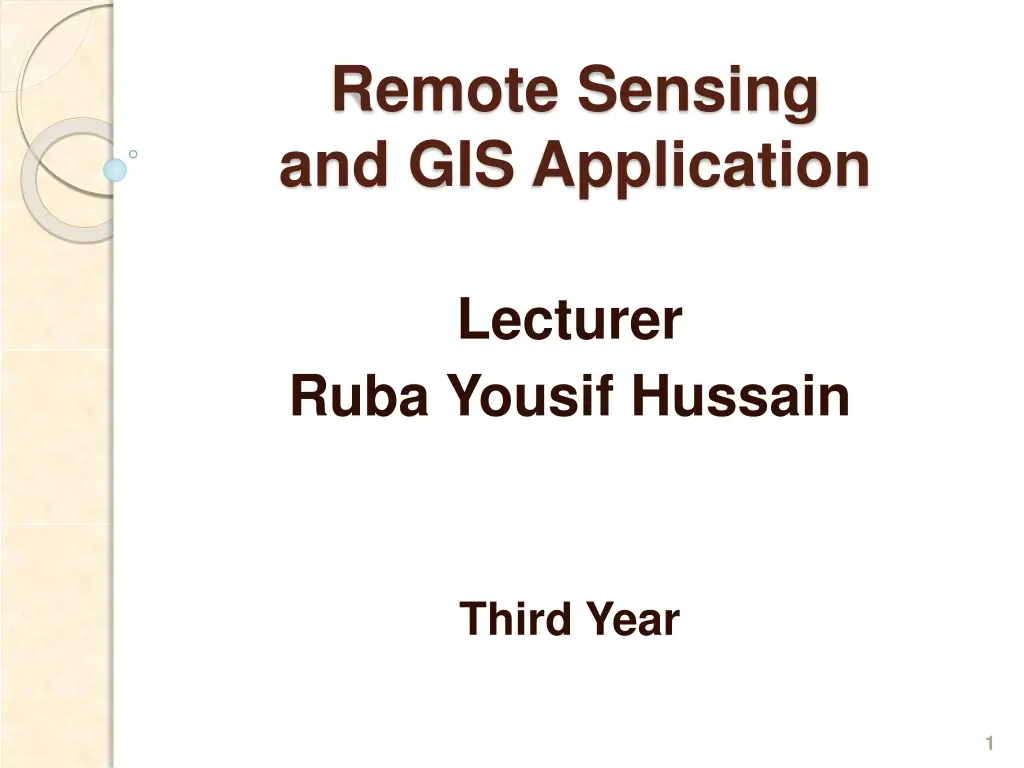
Image Enhancement Techniques in Remote Sensing and GIS Applications
Explore the concepts of image enhancement in remote sensing and GIS applications with lecturer Ruba Yousif Hussain. Discover techniques such as contrast manipulation, spatial feature manipulation, and multi-image manipulation for improving image interpretability and quality. Learn about radiometric, spectral, and spatial enhancement methods to enhance visual clarity and contrast in imagery. Dive into the world of image enhancement with practical application in ArcGIS for dynamic range adjustment and pixel-based enhancement.
Download Presentation

Please find below an Image/Link to download the presentation.
The content on the website is provided AS IS for your information and personal use only. It may not be sold, licensed, or shared on other websites without obtaining consent from the author. If you encounter any issues during the download, it is possible that the publisher has removed the file from their server.
You are allowed to download the files provided on this website for personal or commercial use, subject to the condition that they are used lawfully. All files are the property of their respective owners.
The content on the website is provided AS IS for your information and personal use only. It may not be sold, licensed, or shared on other websites without obtaining consent from the author.
E N D
Presentation Transcript
Remote Sensing and GIS Application Lecturer Ruba Yousif Hussain Third Year 1
Remote Sensing and GIS Application Lecturer Third Year Ruba Yousif Hussain Image Enhancement Image Enhancement The goal of image enhancement is to improve the visual interpretability of an image by increasing the apparent distinction between the features in the scene. Enhancement operations are normally applied to image data after the appropriate restoration procedures have been performed . Digital enhancement techniques can be categorized as 1- Contrast Manipulation - Gray level thresholding - level slicing - contrast stretching 2- Spatial feature manipulation - Spatial filtering - edge enhancement - Fourier analysis 3- Multi-image manipulation - Multispectral band ratioing and differencing - principal components - canonical components - vegetation components - intensity-hue-saturation ( IHS ) color space transformation - decorrelation stretching 2
Remote Sensing and GIS Application Lecturer Third Year Ruba Yousif Hussain The visual quality of an image is related to the range of brightness in the image , known as contrast . A high contrast image has a narrow range of brightness mainly blacks and whites . A low contrast image has a wide range of brightness . Three most important enhancement techniques 1- Radiometric Enhancement Enhancing image based on the values of individual pixels 2- Spectral Enhancement Enhancing image by transforming the values of each pixel on a multiband basis ( Band Ratios , Vegetation Indices , Tasseled Cap ) 3- Spatial Enhancement Enhancing image based on the values of individual and neighboring pixels. 3
Remote Sensing and GIS Application Lecturer Third Year Ruba Yousif Hussain Laboratory Radiometric Enhancement of Imagery Purpose Enhancing image based on the values of individual pixels . Application ArcGIS Contrast Brightness Transparency Gamma Tutorial Dynamic Range Adjustment Background Using ArcGIS as a Viewer for Radiometric Enhancement Zoom To raster Resolution Image Analysis Window Image Analysis Window changes the image on display but does not change the file (original image). 4
Remote Sensing and GIS Application Lecturer Third Year Ruba Yousif Hussain Contrast changes the range of differences between the darkest and lightness objects Brightness will make the image appear lighter or darker Transparency display the image so you can see the image below it Gamma controls relationships between the brightness of original scene and that on the display For example Gamma = 1 , the two images will use the same scale of brightnesses Gamma = 0.5 or 1.5 , the display shows , respectively , either compressed , or expanded, scale of brightness relative to the original. Background eliminates the no data value in the display. Histograms Histograms plot the frequency values of the digital numbers ( DNs ) ( x-axis ) against the number of pixels with that value ( y-axis ) . Remember , the shape of the histogram is determined by the features represented in the image , and their brightnesses ) . ArcMap displays histograms in two ways First : Layer Properties / Symbology tab. 5
Remote Sensing and GIS Application Lecturer Third Year Ruba Yousif Hussain 6
Remote Sensing and GIS Application Lecturer Third Year Ruba Yousif Hussain 7
Remote Sensing and GIS Application Lecturer Third Year Ruba Yousif Hussain Second : Image Analysis window 8






















